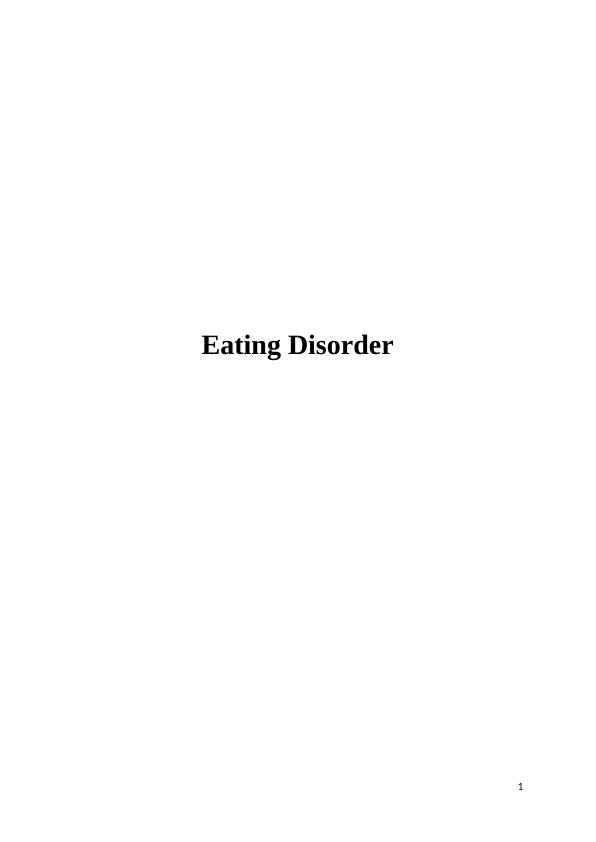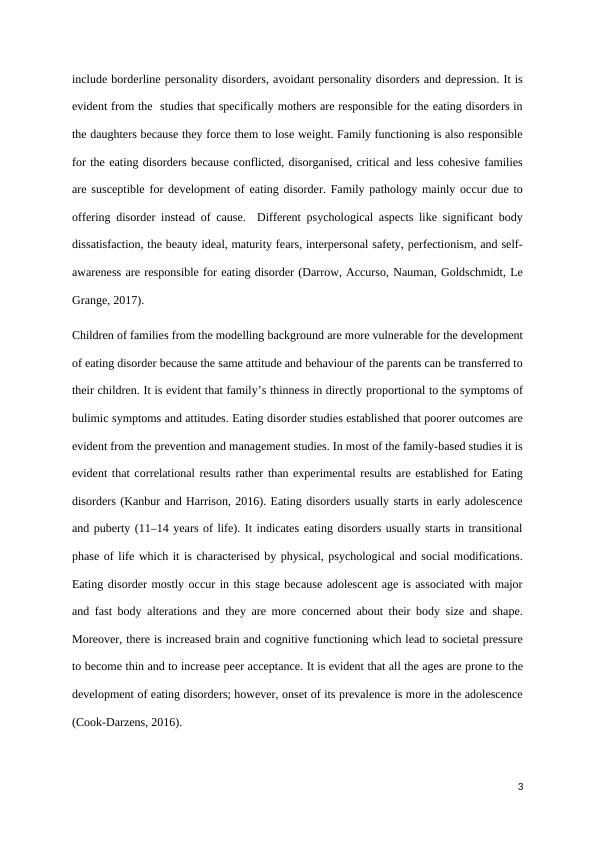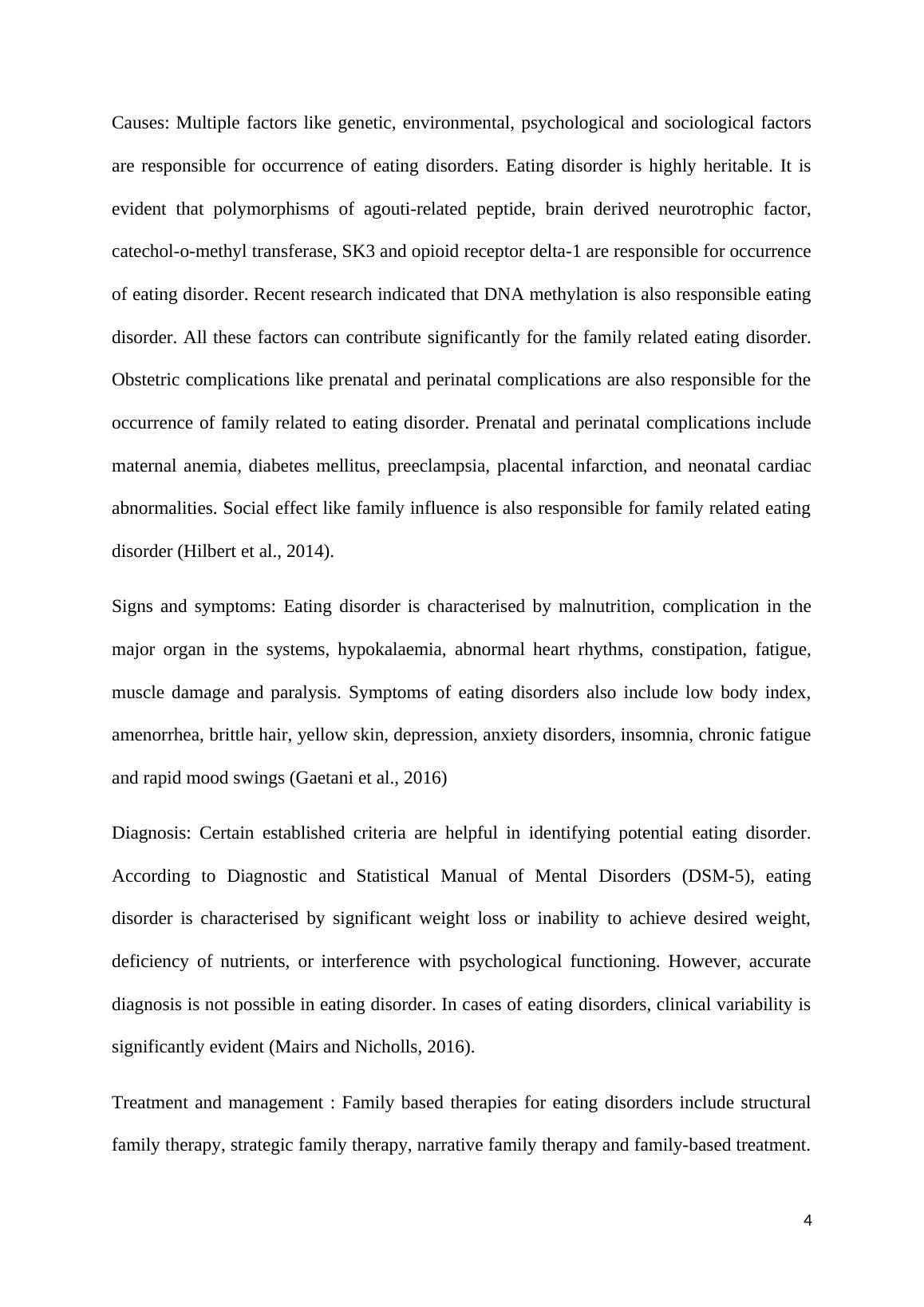Eating disorders Assignment PDF
12 Pages3624 Words288 Views
Added on 2021-12-13
Eating disorders Assignment PDF
Added on 2021-12-13
ShareRelated Documents
Eating Disorder
1
1

Introduction:
Eating disorders are the serious illness which occur specifically in the adolescent and it
impacts adolescence both medically and psychologically. Eating disorders are characterised
by low body weight, fear of weight gain and disturbance in the shape and weight of the body.
It impairs quality of life adversely and it is evident that mortality rate is higher in patients
with eating disorders. Hence, in this essay different aspects of eating disorders like causes,
symptoms, diagnosis and available management options are discussed.
Discussion:
Families with eating disorder: Eating disorders are mainly classified into three types like
anorexia, bulimia and binge eating disorder. Anorexia nervosa is serious mental illness in
which people lose weight due to very less energy intake. People with bulimia nervosa eat
large quantities of food during each cycle. After consumption of large quantities of food, they
try to compensate it by vomiting, consuming laxatives or diuretics, fasting and purging.
People with binge lose control over eating and consume large quality of food on the regular
basis. Epidemiological studies indicated that prevalence of anorexia nervosa, bulimia nervosa
and binge eating disorder is 0.3 %, 0.9 % and 1.6 % respectively. Eating disorders occur in
5.7 % and 1.2 % girls and boys respectively (Erzegovesi and Bellodi, 2016).
Family treatments for eating disorders should be given to both patient and other family
members. It is necessary to consider family members for the treatment of eating disorders
because genetic predispositions are potential factors for changing eating behaviours and
preferences. Family members influence types of foods, style of eating and availability of
foods. From the studies, it is evident that few family’s food choices lead to disordered eating.
Studies demonstrated that family’s associated with psychiatric disorders are more vulnerable
to development of eating disorders (Mairs and Nicholls, 2016). These psychiatric disorders
2
Eating disorders are the serious illness which occur specifically in the adolescent and it
impacts adolescence both medically and psychologically. Eating disorders are characterised
by low body weight, fear of weight gain and disturbance in the shape and weight of the body.
It impairs quality of life adversely and it is evident that mortality rate is higher in patients
with eating disorders. Hence, in this essay different aspects of eating disorders like causes,
symptoms, diagnosis and available management options are discussed.
Discussion:
Families with eating disorder: Eating disorders are mainly classified into three types like
anorexia, bulimia and binge eating disorder. Anorexia nervosa is serious mental illness in
which people lose weight due to very less energy intake. People with bulimia nervosa eat
large quantities of food during each cycle. After consumption of large quantities of food, they
try to compensate it by vomiting, consuming laxatives or diuretics, fasting and purging.
People with binge lose control over eating and consume large quality of food on the regular
basis. Epidemiological studies indicated that prevalence of anorexia nervosa, bulimia nervosa
and binge eating disorder is 0.3 %, 0.9 % and 1.6 % respectively. Eating disorders occur in
5.7 % and 1.2 % girls and boys respectively (Erzegovesi and Bellodi, 2016).
Family treatments for eating disorders should be given to both patient and other family
members. It is necessary to consider family members for the treatment of eating disorders
because genetic predispositions are potential factors for changing eating behaviours and
preferences. Family members influence types of foods, style of eating and availability of
foods. From the studies, it is evident that few family’s food choices lead to disordered eating.
Studies demonstrated that family’s associated with psychiatric disorders are more vulnerable
to development of eating disorders (Mairs and Nicholls, 2016). These psychiatric disorders
2

include borderline personality disorders, avoidant personality disorders and depression. It is
evident from the studies that specifically mothers are responsible for the eating disorders in
the daughters because they force them to lose weight. Family functioning is also responsible
for the eating disorders because conflicted, disorganised, critical and less cohesive families
are susceptible for development of eating disorder. Family pathology mainly occur due to
offering disorder instead of cause. Different psychological aspects like significant body
dissatisfaction, the beauty ideal, maturity fears, interpersonal safety, perfectionism, and self-
awareness are responsible for eating disorder (Darrow, Accurso, Nauman, Goldschmidt, Le
Grange, 2017).
Children of families from the modelling background are more vulnerable for the development
of eating disorder because the same attitude and behaviour of the parents can be transferred to
their children. It is evident that family’s thinness in directly proportional to the symptoms of
bulimic symptoms and attitudes. Eating disorder studies established that poorer outcomes are
evident from the prevention and management studies. In most of the family-based studies it is
evident that correlational results rather than experimental results are established for Eating
disorders (Kanbur and Harrison, 2016). Eating disorders usually starts in early adolescence
and puberty (11–14 years of life). It indicates eating disorders usually starts in transitional
phase of life which it is characterised by physical, psychological and social modifications.
Eating disorder mostly occur in this stage because adolescent age is associated with major
and fast body alterations and they are more concerned about their body size and shape.
Moreover, there is increased brain and cognitive functioning which lead to societal pressure
to become thin and to increase peer acceptance. It is evident that all the ages are prone to the
development of eating disorders; however, onset of its prevalence is more in the adolescence
(Cook-Darzens, 2016).
3
evident from the studies that specifically mothers are responsible for the eating disorders in
the daughters because they force them to lose weight. Family functioning is also responsible
for the eating disorders because conflicted, disorganised, critical and less cohesive families
are susceptible for development of eating disorder. Family pathology mainly occur due to
offering disorder instead of cause. Different psychological aspects like significant body
dissatisfaction, the beauty ideal, maturity fears, interpersonal safety, perfectionism, and self-
awareness are responsible for eating disorder (Darrow, Accurso, Nauman, Goldschmidt, Le
Grange, 2017).
Children of families from the modelling background are more vulnerable for the development
of eating disorder because the same attitude and behaviour of the parents can be transferred to
their children. It is evident that family’s thinness in directly proportional to the symptoms of
bulimic symptoms and attitudes. Eating disorder studies established that poorer outcomes are
evident from the prevention and management studies. In most of the family-based studies it is
evident that correlational results rather than experimental results are established for Eating
disorders (Kanbur and Harrison, 2016). Eating disorders usually starts in early adolescence
and puberty (11–14 years of life). It indicates eating disorders usually starts in transitional
phase of life which it is characterised by physical, psychological and social modifications.
Eating disorder mostly occur in this stage because adolescent age is associated with major
and fast body alterations and they are more concerned about their body size and shape.
Moreover, there is increased brain and cognitive functioning which lead to societal pressure
to become thin and to increase peer acceptance. It is evident that all the ages are prone to the
development of eating disorders; however, onset of its prevalence is more in the adolescence
(Cook-Darzens, 2016).
3

Causes: Multiple factors like genetic, environmental, psychological and sociological factors
are responsible for occurrence of eating disorders. Eating disorder is highly heritable. It is
evident that polymorphisms of agouti-related peptide, brain derived neurotrophic factor,
catechol-o-methyl transferase, SK3 and opioid receptor delta-1 are responsible for occurrence
of eating disorder. Recent research indicated that DNA methylation is also responsible eating
disorder. All these factors can contribute significantly for the family related eating disorder.
Obstetric complications like prenatal and perinatal complications are also responsible for the
occurrence of family related to eating disorder. Prenatal and perinatal complications include
maternal anemia, diabetes mellitus, preeclampsia, placental infarction, and neonatal cardiac
abnormalities. Social effect like family influence is also responsible for family related eating
disorder (Hilbert et al., 2014).
Signs and symptoms: Eating disorder is characterised by malnutrition, complication in the
major organ in the systems, hypokalaemia, abnormal heart rhythms, constipation, fatigue,
muscle damage and paralysis. Symptoms of eating disorders also include low body index,
amenorrhea, brittle hair, yellow skin, depression, anxiety disorders, insomnia, chronic fatigue
and rapid mood swings (Gaetani et al., 2016)
Diagnosis: Certain established criteria are helpful in identifying potential eating disorder.
According to Diagnostic and Statistical Manual of Mental Disorders (DSM-5), eating
disorder is characterised by significant weight loss or inability to achieve desired weight,
deficiency of nutrients, or interference with psychological functioning. However, accurate
diagnosis is not possible in eating disorder. In cases of eating disorders, clinical variability is
significantly evident (Mairs and Nicholls, 2016).
Treatment and management : Family based therapies for eating disorders include structural
family therapy, strategic family therapy, narrative family therapy and family-based treatment.
4
are responsible for occurrence of eating disorders. Eating disorder is highly heritable. It is
evident that polymorphisms of agouti-related peptide, brain derived neurotrophic factor,
catechol-o-methyl transferase, SK3 and opioid receptor delta-1 are responsible for occurrence
of eating disorder. Recent research indicated that DNA methylation is also responsible eating
disorder. All these factors can contribute significantly for the family related eating disorder.
Obstetric complications like prenatal and perinatal complications are also responsible for the
occurrence of family related to eating disorder. Prenatal and perinatal complications include
maternal anemia, diabetes mellitus, preeclampsia, placental infarction, and neonatal cardiac
abnormalities. Social effect like family influence is also responsible for family related eating
disorder (Hilbert et al., 2014).
Signs and symptoms: Eating disorder is characterised by malnutrition, complication in the
major organ in the systems, hypokalaemia, abnormal heart rhythms, constipation, fatigue,
muscle damage and paralysis. Symptoms of eating disorders also include low body index,
amenorrhea, brittle hair, yellow skin, depression, anxiety disorders, insomnia, chronic fatigue
and rapid mood swings (Gaetani et al., 2016)
Diagnosis: Certain established criteria are helpful in identifying potential eating disorder.
According to Diagnostic and Statistical Manual of Mental Disorders (DSM-5), eating
disorder is characterised by significant weight loss or inability to achieve desired weight,
deficiency of nutrients, or interference with psychological functioning. However, accurate
diagnosis is not possible in eating disorder. In cases of eating disorders, clinical variability is
significantly evident (Mairs and Nicholls, 2016).
Treatment and management : Family based therapies for eating disorders include structural
family therapy, strategic family therapy, narrative family therapy and family-based treatment.
4

End of preview
Want to access all the pages? Upload your documents or become a member.
Related Documents
Eating Disorder: Causes, Symptoms, Diagnosis and Managementlg...
|12
|3635
|308
Assignment about Bulimia Nervosa and Bingelg...
|6
|1241
|14
Abnormal Psychologylg...
|4
|742
|146
Management of Obesity and Eating Disorders in Adolescents and Childrenlg...
|15
|3587
|122
Anorexia and Bulimia Nervosa - PDFlg...
|4
|609
|89
Multidisciplinary Assessment and Interventions PDFlg...
|11
|2904
|19
